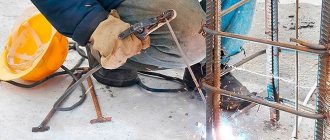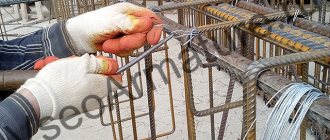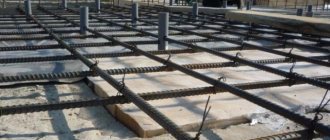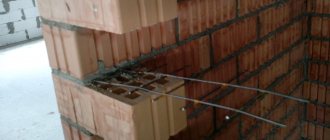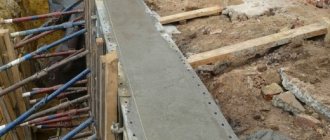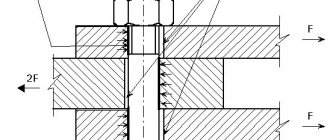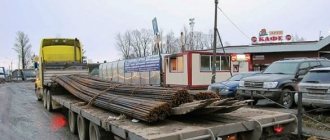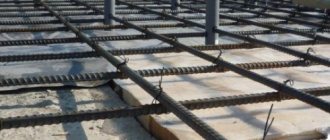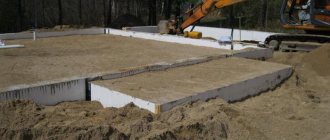When planning the construction of a residential building, every developer dreams that it will be stable and reliably protected from adversity. To do this, you should take a serious approach to achieving your goal, make efforts, and solve many problems. Sometimes the question arises whether the reinforcement for the foundation can be welded. There is a debate going on among builders and private developers. Some confidently claim that it is better to weld frame elements rather than knit. Others doubt whether it is possible to weld foundation reinforcement. Let's try to understand this issue.
What is the purpose of reinforcement in the foundation?
A professional approach to foundation construction guarantees a long service life of the building. A strong base maintains its integrity, as it is resistant to cracks as a result of soil shrinkage. Ensuring the strength of the foundation using a space frame is a significant challenge. It is important to carefully consider the design features of a reinforced structure, for the manufacture of which steel rods or metal mesh can be used.
For small buildings, a strip-type foundation is often used as a foundation. If manufactured correctly, it ensures the stability of buildings for a long time. It is impossible to form a reliable foundation by pouring the foundation with a concrete mixture without additional reinforcement. In this case, as a result of deformation, after a certain period of time it will crack.
When laying the foundation, the reinforcement can be connected in two main ways: welding or tying
Properly performed reinforcement helps prevent premature damage to the integrity of the base. The range of reinforcement is determined by calculation.
The use of steel rods allows:
- significantly increase the strength of the foundation;
- ensure uniform distribution of current forces;
- dampen the soil reaction as a result of frost heaving;
- ensure a long service life of the building.
Strengthening the base protects it from cracks caused by deformation.
Influencing factors
You can generate a list of conditions influencing the choice of the type of connection of metal rods for foundations:
- Natural. According to the existing construction rules SNiP 52-01-2003, welded joints cannot be used on moving soils.
- Technical characteristics of the building. High-rise multi-storey buildings require high-speed construction, and for their construction it is recommended to use welded connections of reinforcing mesh and frames of foundation structures. Shallow foundations of private houses and small structures are best built on foundations using bonded metal products.
- Connection materials. Not every type of reinforcing bars can be welded using electric arc welding, which destroys the integrity of the bars and reduces their strength.
- Special equipment. Welding machines must be equipped with a regulator for smooth adjustment of the current strength.
- An appropriately qualified performer. High-quality welding can only be performed by an experienced welder. It is impossible to redo a poorly done job.
Reinforcement tying sequence
Knitting or welding - the methods used for connecting rods
To increase the strength of building foundations, various techniques are used. When constructing household buildings, country houses and light buildings, private developers add pieces of metal, glass fragments and various construction waste to the concrete solution. For light ancillary buildings this is acceptable. However, a durable residential building requires reliable reinforcement of the foundation using reinforcing bars or steel mesh. They are cut into pieces of the required size and placed in trenches.
There is no consensus on whether it is possible to weld foundation reinforcing bars together
To ensure increased strength of the base, the rods are combined into a power circuit using various methods:
- by tying together reinforcing bars or lattice pieces using tying wire. To increase flexibility, it is fired and allows you to quickly fix the frame elements using a crochet hook;
- using electric welding. In the manufacture of frames at industrial enterprises, resistance spot welding can be used. In domestic conditions, reinforcing bars are welded using the usual method.
Each method of fixing rods has certain advantages and weaknesses. Let's analyze each mounting option in detail.
Flaws
It is worth considering the negative impact of welding on the fastening of reinforcement elements. Reinforcement of a frame made of metal rods can be made in the form of:
- U-shaped;
- L-shaped reinforcement.
The very process of fastening elements by welding has a huge impact on the result of reinforcing the frame rods. When exposed to high temperatures on the elements from which the base structure is created, its structure undergoes some changes, and, in fact, partial destruction. Thus, the very strength of the connecting element decreases, unless welding is carried out in a factory environment, where it is tested for all types of loads. There are some restrictions that are applied by specialists in the field of welding metal structures for foundation construction. They are provided in order to minimize the negative impact of this method of fastening elements during the construction of the foundation.
How to knit a reinforcement cage - methods of fixing the rods
Tying steel bars into a metal frame is carried out using various methods. It is possible to order a ready-made frame assembled using knitting wire at a specialized enterprise. However, this entails additional costs associated with its delivery to the site. For small volumes of construction this is quite expensive and impractical. It’s easy to learn the knitting technique on your own and do all the work yourself.
Knitting reinforcement for the foundation is used somewhat more often than the welding method
Observe the following sequence of operations:
- Develop a drawing or sketch of the future reinforcement grid.
- Calculate the total number of areas to be fixed.
- Cut pieces of wire with a diameter of 1.2 mm, 30 cm each.
- Bend a piece of wire in half to form a loop and bring it to the joint of the bars.
- Grab the ends of the wire with a crochet hook and pull through the loop.
- Check the tightness of the wire covering the connection area.
- Rotate the working device, ensuring that the parts are tightly tightened.
Using a crochet hook to secure parts is an inexpensive way to fasten elements. It does not require the use of special tools and allows the work to be completed with the help of auxiliary workers.
To reduce the duration of work and make knitting easier, you can use:
- a special gun that automatically feeds the wire. Working with it requires certain qualifications;
- household electric tool with a rotating chuck. An electric drill or screwdriver equipped with an attachment is quite suitable.
Knitting a frame is inherently the simplest way to connect.
The main advantages of automated devices:
- significant increase in productivity;
- facilitating fixation in hard-to-reach areas;
- significant reduction in labor intensity.
Having mastered the technology of hand knitting, you can do the work of fixing the elements of the reinforcement frame on your own.
On the welder's qualifications for reinforcement
Anyone can use a modern welding machine.
But in the case of frame reinforcement, welding only involves tackling the rods, but not welding in the full sense of the term. GOST 14098-2015 K3-Rp defines cross-shaped joints by manual arc welding as non-design or installation, which do not require high qualifications of the performer and, as a rule, are performed by resistance welding. Only in exceptional cases, specified in clause 4.2.8 of RTM 393-94, are such connections transferred to the design category. That is why those who perform welding work in the reinforcement shops of reinforced concrete factories have never been considered welders.
The split strands must be welded, because they take the load along their entire length and there is a possibility of them spreading when pouring concrete.
Design of the punching zone - welding of reinforcement for the foundation is performed only by a highly qualified welder. This is a responsible area that requires a lot of knowledge and professional skills. In this case, inept actions of the welder can lead to negative consequences: disruption of the structure of the rods with loss of strength characteristics.
In construction practice there are terms:
- “Lack of penetration” is a weak connection, with the presence of cavities and cavities.
- “Undercut” is a weakening of the main longitudinal rod.
The first is a consequence of the welder’s unprofessionalism.
The second definition is caused by the objective properties of the metal - the change in the characteristics of steel when heated. But it is worth considering that there is practically no alternative to welding when using rods with a diameter of 20 mm and above. In this case, the binding wire may burst when pouring the concrete mixture and vibrating, and the question “is it possible to weld reinforcement for the foundation” does not even arise.
How to tie a frame for placement in the foundation
When planning to manufacture a reinforcing grid using the tying method, purchase the required materials and prepare the tools in a timely manner.
Knitting technology is easy to master on your own, following the recommendations given:
- Place the horizontal elements of the lower tier at a fixed distance from the soil level. You can ensure the required gap of 40–60 mm using plastic supports, wooden pads or waste bricks. The frame rods should not touch the ground.
- Ensure that vertical bars are installed at equal intervals between them. Maintaining a constant step will allow you to evenly distribute the load. It is important to protect the elements from contact with the soil using special supports made of non-metallic material.
- Fix the spatial frame reinforcement with binding wire. When performing work, check the reliability of fastening in the connection areas. The elements should not move when pouring concrete into the formwork.
If you have at least a little experience in the field of construction, knitting reinforcement is quite simple
- Maintain equal spacing between the reinforcement located in the horizontal tier, as well as between the vertical elements. It is important to additionally secure the corner reinforcement, which is prone to displacement during the concrete pouring process. The corner parts should not protrude beyond the contour of the base.
- Check the strength of the assembled frame under load. Place a wooden board on the top belt of the metal structure and stand on it. When moving along the board, the frame elements must remain motionless.
Additional fixation of the frame placed in the formwork using wooden blocks will ensure its immobility when filling the formwork with concrete mortar. When purchasing materials for the manufacture of power grids, comply with the documentation requirements for the use of fittings of the required brands and assortment.
Link recommendations
Before you start work, prepare the material and tools. The reinforcement must be pre-cut if necessary. Decide in advance on the shape of the reinforcement cage. We recommend connecting the rods so that they form a square at the junction.
If you are assembling the frame outside, then this can be done directly on the ground. One side of the “square” will require three reinforcements. Take three rods and place them parallel to each other. First place a couple of bricks or boards under the bars so that the reinforcement does not touch the soil.
The distance between the rods should be from 4 to 6 cm. The pitch should be constant so that the load is distributed evenly. That is, if, when assembling the first side of the frame, you made a gap of 5 cm between the three rods, then maintain it throughout the entire time.
Make clamps from thick wire. The picture below shows the location of the reinforcing bars and clamps.
Now you must connect the rods and clamps. For this, a special thin wire and hook are used. There are many ways to make a knot. One of them is shown in the picture below. Instead of a hook, you can use a special gun, but then the cost of the work will increase.
One loop is used to connect the reinforcement. There is a method of joining with two loops, but it is rarely used since one loop is enough to provide sufficient rigidity. Yes, and it’s not difficult to learn. Watch a few videos on the Internet. It describes and shows in detail the process of tying the reinforcement.
The standard wire consumption per knot is about 20 cm. A beginner will need more material, but you need to strive for this indicator so as not to overpay for wire.
Remember: the better the frame is knitted, the better. Of course, if you burst one or two ligaments, the foundation will not suffer much. It is important that the structure is rigid when pouring concrete. But if there are a lot of such flaws, then the frame will become movable, and this is bad. Make sure that the reinforcement is tightened with sufficient force.
Welding reinforcement for the foundation - work technology
Currently, along with bonding, welding of foundation reinforcement is also used. This method of connecting frame elements is used in the construction of multi-story buildings, the foundations of which absorb significant forces. This necessitates the need to ensure increased strength of the joints. Welded fittings made from A400C corrugated wire are welded well, just like A500C rod. Spot welding of reinforcement ensures reliable fixation of rods with a diameter of up to 25 mm.
Welding reinforcement can significantly simplify the process of laying the foundation as a whole.
Overheating of rods during welding work can cause the following negative phenomena:
- change in metal structure;
- reduction in strength properties.
When work is performed by experienced welders and assembly is carried out under laboratory control in industrial enterprises, these factors can be avoided.
The algorithm for manufacturing reinforcing bars by welding in industrial enterprises is carried out as follows:
- Incoming quality control of purchased materials that will be used to assemble the frame is carried out.
- Rods whose characteristics do not meet the requirements of regulatory documentation are rejected.
- Reinforcing bars are cleaned of rust, straightened, treated with abrasive and cut into blanks of the required sizes.
- The elements of the future frame are connected in one plane by light tack welding until final fixation.
- The frame blanks are fixed with welding jigs at a distance corresponding to the requirements of the drawing.
- The structure is tacked by welding and the dimensions of the space frame are checked for compliance with the documentation requirements.
It is equally important to choose the correct current value with which you will weld the frame.
The design features of welding jigs allow you to assemble rods with a tolerance not exceeding 3 mm. The sequence of operations for manufacturing a frame by welding on a construction site is similar. Spot welding of reinforcement allows you to fix steel rods of a spatial structure located at different angles, as well as in a suspended state. The installation is equipped with conductive clamps, which expand its capabilities.
Minimizing negative impacts
It is clear that natural factors cannot be overcome (at least in most cases). However, it is considered quite possible to reduce the negative impact of welding on metal in construction work. Experts have developed a whole range of measures aimed at minimizing losses during welding operations.
- Selection of reinforcement for the frame. It is strongly recommended to use rods classified as A400C or A500C. Their diameter and carbon content in the metal are optimal for equipping the supporting structure by welding.
- Selection of electrodes. They must correspond to the diameter of the elements assembled into the frame. If relatively thin rods are to be used, most commercially available electrodes will suffice. If the reinforcement frame is constructed from elements with a diameter greater than 14 mm, you will have to stock up on specialized electrodes for these cases. Moreover, it is advisable to purchase those that are designed to work with low-carbon steel. Such electrodes have a less intense impact on the metal during welding and will provide a structure with greater strength.
- Welding machine. For welding reinforcement for the foundation, when connecting reinforcing elements, it is recommended to use equipment with continuously variable control of the supplied current. Insufficient current will not make it possible to achieve a reliable, durable and high-quality seam, which can subsequently lead to subsidence of the foundation, or even to the destruction of the building as a whole. An excessively intense current will overheat the metal, and the reinforcing element will become brittle after cooling.
Need a welding machine
- In order for the welded joint to be as strong as possible, it is necessary to press the welded elements together as tightly as possible. However, this is quite difficult to do. Some craftsmen advise using a grinding tool. The rods are cleaned to relative smoothness, and the connection area of the reinforcement increases.
And finally, there are recommendations in construction work for treating seams with anti-corrosion compounds. At the point of welding, the metal becomes more vulnerable to moisture, and the solution from which the foundation is poured contains plenty of it and takes a long time to dry.
Boil or knit: which method to choose?
Careful consideration must be given before making a final decision about whether to use ties to fasten steel bars or fasten them by welding. Why do some builders weld reinforcement while others knit it? Each method has its own advantages and weaknesses.
To avoid mistakes, you should listen to the advice of professionals:
- For massive multi-story buildings that place a significant load on the foundation, it is advisable to use welding. At the same time, it is important not to burn out the reinforcement, so as not to weaken the strength of the connection;
- for small residential buildings and country houses, you can use the connection of parts of the reinforcing lattice using knitting wire. This method of fixation ensures the strength of such buildings.
When using welding, it is important to eliminate the possibility of burnout, which weakens the strength of the joints. It is undesirable to use the welding connection method in seismically active zones, as well as on problematic soils, where the integrity of the foundation may be compromised as a result of soil displacement.
However, welding has a number of advantages:
- allows you to perform work at an accelerated pace;
- provides increased rigidity of the space frame;
- increases the load capacity of the base.
When constructing private buildings, it is better to use the knitting method. Advantages of this method:
- ease of implementation and no need for special equipment;
- the ability to perform work without the involvement of qualified specialists;
- absence of increased stresses in the joining areas.
The disadvantage of the knitting method is the insufficient rigidity of the reinforcement grid. However, when constructing light buildings, this drawback is not significant.
Methods for connecting reinforcing elements
There are various methods to increase the strength characteristics of the foundation. Private developers use any available material (waste metal, broken glass, etc.). For country houses this is an acceptable option. But to build a reliable house, even a one-story one, use proven technologies for strengthening with metal mesh or rods. If your choice is a mesh, then you only need to cut it correctly and install it properly in the prepared trenches. The use of metal elements implies the creation of a single structure from them, the so-called frame.
It is worth knitting reinforcement in cases where you need to get a good foundation on difficult soil
There are two ways to achieve this:
- tie using flexible wire for connection;
- apply welding to fix the structural elements.
Both options have strengths and weaknesses. Let's conduct a comparative analysis of each of them.
Materials and equipment
Continuing to understand the question of whether it is necessary to weld reinforcement for the foundation, you need to pay attention to the devices and consumables used for this purpose.
It is recommended to use an inverter that performs resistance welding and operates on direct current. It is much more efficient than its transformer counterparts, which require variable current.
The semi-automatic unit works with special electrodes capable of cooking in an environment saturated with protective gases. The equipment has a special mechanism with protective properties that feeds electrodes automatically.
An inexpensive but outdated option is a welding transformer, which connects the fittings using electrodes that receive alternating current. This type of equipment works through a rectifier that converts alternating current into direct current. Like other equipment, resistance welding units are divided into two groups - professional devices and household ones.
The electrodes used for welding change the chemical composition of the connecting seam. Such elements are based on metal rods coated with a special composition that burns during welding.
This consumable material is marked as follows:
- “U” – resistance welding is allowed for products made of low-alloy metal;
- “L” – frames can be formed from alloyed metal;
- “T” – heat-resistant alloys are welded;
- “B” - such electrodes are recommended for joining high-alloy steel products;
- “N” – with their help additional layers are deposited.
In addition to the consumables discussed here, solid or flux-cored wire is used during welding, with the help of which weld deposits are formed.
Flux-cored wire has a special composition that facilitates the formation of a seam and increases its quality level. The diameter of such wire varies from 0.3 to 12 mm.
For a semi-automatic unit, it is recommended to use wire 0.3 – 1.6 mm.
